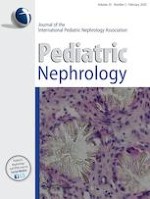Erschienen in:

06.11.2019 | Original Article
Histological prognostic factors in children with Henoch-Schönlein purpura nephritis
verfasst von:
Jean-Daniel Delbet, Guillaume Geslain, Martin Auger, Julien Hogan, Rémi Salomon, Michel Peuchmaur, Georges Deschênes, David Buob, Cyrielle Parmentier, Tim Ulinski
Erschienen in:
Pediatric Nephrology
|
Ausgabe 2/2020
Einloggen, um Zugang zu erhalten
Abstract
Background
The management of IgA vasculitis with nephritis (IgAVN) remains controversial because of the difficulty to identify prognostic factors. This study reports the prognosis of children with IgAVN in relation to histological parameters.
Methods
All children with IgAVN diagnosed between 2000 and 2015 in three pediatric nephrology centers were included. The following histological parameters were analyzed: mesangial proliferation (MP), endocapillary proliferation (EP), crescents, active, or chronic tubular and interstitial lesions (TIa lesions/TIc lesions), and segmental glomerulosclerosis (GS). Clinical and biological data were collected at the time of renal biopsy. The primary endpoint was IgAVN remission defined as a proteinuria < 200 mg/l without renal failure.
Results
One hundred fifty-nine children were included with a median age of 7.6 years. Acute glomerular or TI lesions including MP, EP, crescents, and TIa lesions were observed, respectively, in 81%, 86%, 49%, and 21% of patients. Chronic glomerular lesions including GS and TIc lesions were observed in 6 and 7% of patients. Median initial proteinuria was 330 mg/mmol, albuminemia 32 g/l, and eGFR 110 ml/min/1.73 m2. One hundred twelve (70%) patients were in remission at the end of a median follow-up of 37.4 months. Chronic lesions were significantly associated with the absence of remission in multivariate analysis, whereas EP, crescents and TIa were not associated with a poor prognosis.
Conclusions
Of children with IgAVN, 30% present a persistent renal disease at the end of a 3-year follow-up. Chronic histological lesions, but not EP or crescents, are associated with a bad prognosis and must be evaluated in IgAVN histological classification.